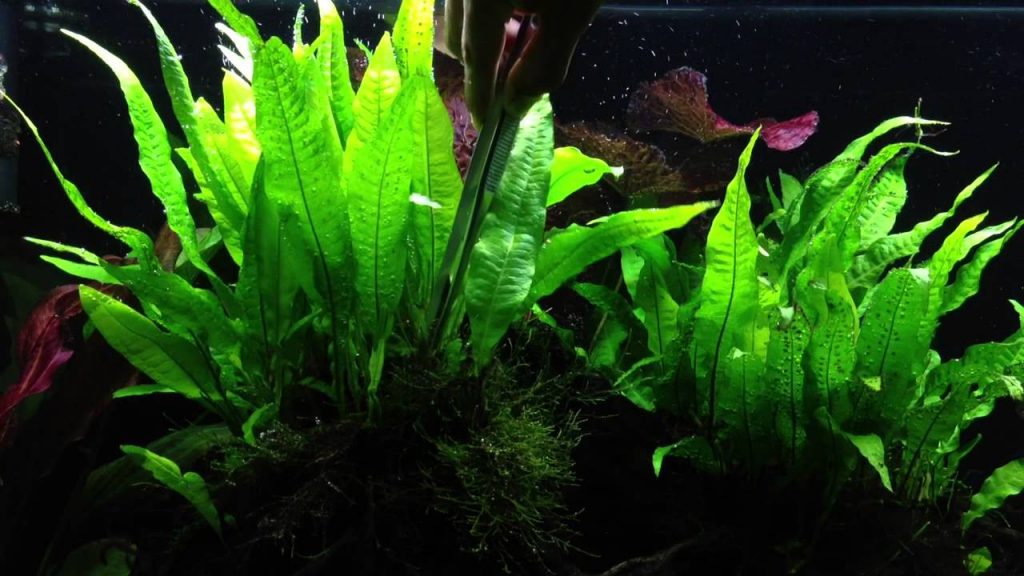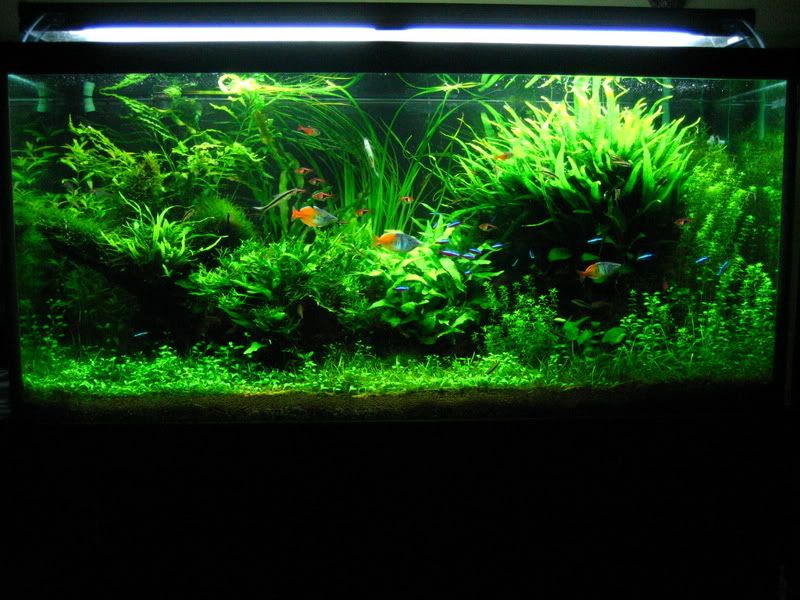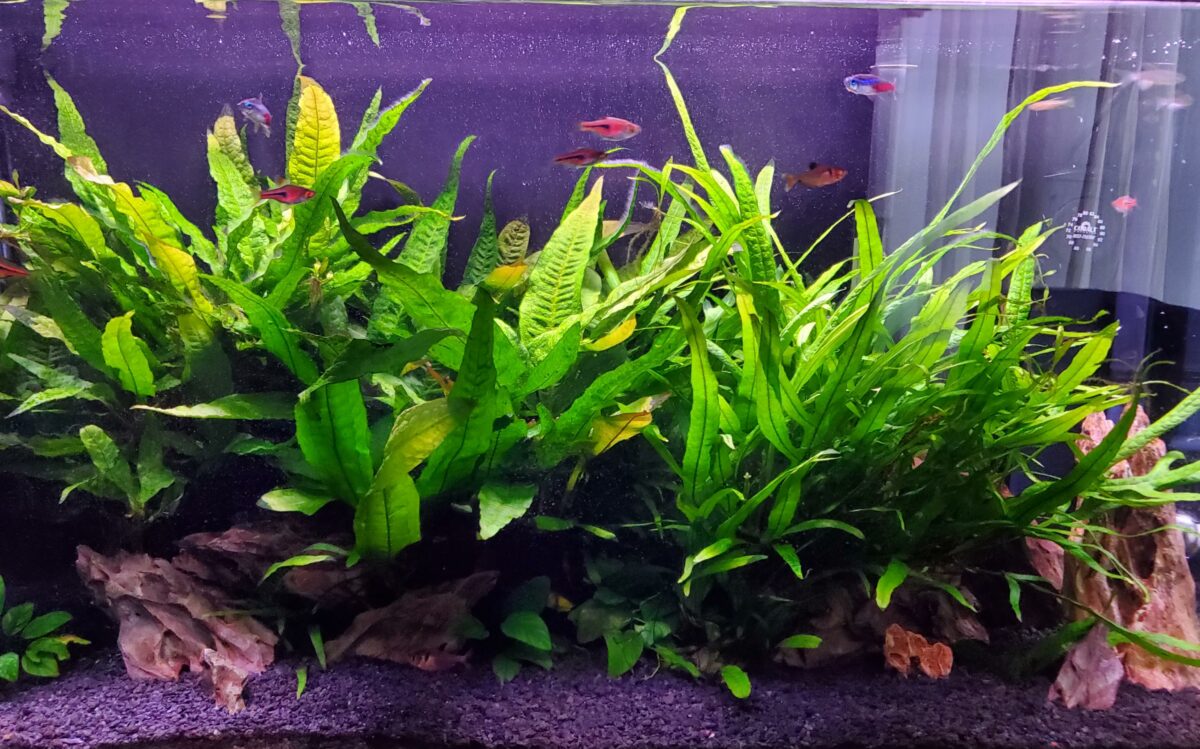The freshwater aquarium is set, the fish are swimming, and, well, you decide to liven it up and bring some greenery indoors with some live plants. We strongly advise you to visit the store and pick up some Java ferns! Java fern plants are one of the biggest sellers, being in demand by aquarists for their easy maintenance. They’re also presentable and aesthetically appealing for your living space.
Contents
General Species Information
Java fern, as the name suggests, is native to the lush green areas of Southeast Asia. It mainly comes from regions in Thailand, Malaysia, China, and Northeast India. The Java fern thrives well under temperatures ranging from 21 to 28 degrees Celsius. It’s a jungle plant that can be seen growing in tropical rainforest, grass, and rock surfaces.
Its major components include the rhizome, the root system, and the leaves. The rhizome is the energy house of the plant. Although they look like dark-green roots, the rhizomes are the plant’s stems and they absorb most of the nutrients for the plant’s survival. The brown roots play a minimum but essential role by attaching to whatever surface is provided and stationing the plant in one place.
The leaves are hardy and robust and the leaf shape depends on the type of Java fern. The leaves develop black spots, which enable them to clone themselves and produce plantlets that will later make new plants.
Java Fern Varieties

Java fern belongs to the Polypodiaceae family and is considered to be a true aquatic plant, for it grows while wholly immersed in water. Its scientific name is Microsorum Pteropus and comes in a few varieties. These include:
- Microsorum Pteropus Narrow Leaf
Narrow-leaf Java fern has thin, elegant leaves maturing with an acute angle to the stem. Because of the thin leaves, it’s best not to keep them with giant crayfish.
- Microsorum Pteropus Needle Leaf
This is a rare but vibrant and busy group of Java ferns. It’s an ideal accessory pursued in the aquarium hobby for its narrow and intricate foliage that adds detail to the fish tank. Its ribbon-like leaves and slender shape make this Java fern variety a sleek fit for a classy planted aquarium setup.
- Microsorum Pteropus Trident
This is a rare species of Java fern originating from Borneo. The uniqueness lies in its trident design with leaves forked to the central plant.
- Microsorum Pteropus Windelov
The green, finely branched leaf tips give a frilly look to the Windelov Java fern, thus making it attractive and enhancing the aquarium decor. This variety can grow in numerous water parameters and low-light conditions.
Apomixis: How Java Ferns Reproduce
Unlike the usual reproduction by generating seeds, Java ferns have a unique plant propagation process that involves cloning themselves. The black bumps that develop on the ferns will soon produce plantlets supported by a nutrient-rich environment. The plantlets grow just beneath the parent Java fern plant.
While still attached to the parent plant, the plantlet will develop its root base and will ultimately break away from the parent plant and flow to anchor itself someplace else. This process of plant propagation of the Java fern is referred to as “Apomixis.”
Java Fern in the Aquarium

Java fern is a robust plant and an easy pick for aquarists, regardless of whether they are beginners or advanced. It’s a smart and efficient choice as an aquatic plant for those starting with the hobby of setting up planted tanks. They are low on maintenance, require a non-fancy substrate, are easy to propagate, and thrive in the worst water conditions. Even though some say that Java ferns can survive in brackish water, it’s best to go with soft freshwater. This plant has tough leaves and is a robust and hardy aquarium plant choice. Java ferns provide a whole range of benefits.
They are traditional green aquarium plants that provide adequate shelter, a grazing area, and cover to the fish with their long swaying leaves. They mimic the habitat of the fish species, thus providing them with an ideal ecosystem. They are humble and undemanding plants. They can sustain themselves in a wide range of conditions. Therefore, they do not have specific lighting requirements and require very little fertilization.
They can pull through a wide range in the temperature and pH scale when it comes to the water, and, in fact, give back by absorbing the nitrates from the water, thus functioning as great cleansing agents. While you would find many aquariums having fancy installations like carbon dioxide systems, Java ferns would happily support themselves in a minimalistic setup.
With its long, tender leaves and bushy structure, Java fern is also an excellent addition to one’s aquascape. Depending on your fish tank size, Java fern can be an amazing mid or background plant. Java ferns, however, have a slow growth rate and only some basic care and maintenance requirements. It’s a great-looking plant, can thrive in a wide range of conditions, and can coexist with various fish species, including cichlids and goldfish.
It’s one of the traditional green aquarium plants with black bumps and black lines. The black nodes denote the propagation of the plant, while the black lines depict the veins.
Planting Java Fern in the Aquarium
Java fern is hard and stiff. This plant is attached or left to float. However, at the beginning of its life cycle, the roots aren’t strong enough. Thus, large fishes in your tank could destroy the plants and hamper their growth. Therefore, experts recommend tying this plant to a piece of driftwood or some sturdy anchor. Java ferns are epiphytic aquarium plants, meaning they don’t need to be rooted in the soil but can grow when attached to a hardscape. Java ferns are usually attached to rocks, shells, driftwood, super glue gel, or fishing line. They grow best on wood or rock anchors.
An important point to be kept in mind is that the rhizome needs to stay above the substrate. Otherwise, it won’t be able to absorb the required nutrients from the water and ultimately rot. The Java ferns supported by fertilizer and lighting could grow up to 6 to 8 inches, thus taking over a big portion of the space. Therefore, it’s ideal to use such big plants as the center plants of the aquarium ecosystem to further enhance their beauty.
Java Fern Care Guide
While Java ferns are generally self-sufficient, they do require some care to stay healthy. Otherwise, you might end up having a pile of dead leaves or pale-brown edges to your Java ferns that are indicative of their downfall. There could be black spots (not to be confused with the black pods on the leaves that reproduce into new plantlets), indicating deterioration. Most of these failed cases of growing Java ferns indicate a potassium deficiency.
Java ferns and other plants like Anubias have a specific requirement for potassium to grow and thrive. Carbon dioxide injections are said to promote the plant’s growth as for any plant. Liquid fertilizers like Seachem Flourish or API Leaf Zone (both listed on Amazon) are also great for promoting healthy growth. The macronutrients for Java ferns include iron, manganese, nitrogen, and phosphorus.
Java ferns require moderate lighting and can survive in low-light conditions. Intense lighting might damage the aquatic fern and result in scorched leaves. Since Java ferns do not have roots that function to absorb nutrients from the soil, they need regular fertilization so that the rhizome can take the required nutrients from the water.
This plant usually thrives in freshwater but can also support itself in brackish, salty water systems. Normally, regular water changes and cleaning of the aquarium will be enough to maintain the hygiene of the ecosystem. Pruning from time to time also helps maintain the health of the plants and enables one to filter out the unneeded. Since Java ferns grow slowly, you’ll probably need to prune them once a year, unless your fish tank is really small and they tend to outgrow it. In this case, you’ll need to prune them more often.
Though Java ferns should cause you the least trouble, they are not immune from breakdowns. Java fern melt is a condition that’s characterized by the development of large brown spots. Cyanobacteria attack in the fish tank might also cause concern for Java ferns. However, changing the water and injecting adequate nutrition should solve the problem.
Fishes and Java Ferns

Fishes, almost all kinds, and Java ferns have a peaceful coexistence. Most fish don’t bother disturbing the ferns as they are complex and leathery for them to feast on. It’s also said that Java ferns are not very tasty for the school of fish. Thus, even having herbivorous fish in your tank might not be a significant problem.
With their leaves, Java ferns provide a good playing ground for the fish to hide and seek. Bettas, in particular, are said to appreciate the Java plants for they provide the ideal grounds for them to feel secure.
Conclusion
The humble Java fern is not short of being declared the best aquarium plant by popular mandate. It’s ideal from a maintenance and aesthetic perspective. It has a unique leaf structure, a robust survival spree, and minimum requirements. It requires very little care once it has been planted and can produce more ferns.
It is, however, important not to take the plant for granted. Adequate care is an essential aspect of getting benefits from anything. Thus, regular fertilization, regular checking to find abnormalities in the plant growth, and proper treatment are desired. Nature will give us back as much as we give it. So will the beautiful Java fern!

Ian Sterling, founder of Fishlab.com, began his aquarium journey over 30 years ago, driven by a deep fascination for fish and their diverse personalities. His website, Fishlab.com, is dedicated to making fishkeeping accessible and enjoyable, offering beginner-friendly guidance, expert insights, and a community for aquarists to connect and share experiences.


